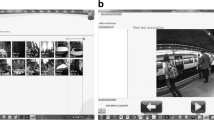Abstract
Daily diaries are a widely used measurement tool in studies on the use of social time. However, while their high level of accuracy is supported by a lot of research, scholars often voice doubts regarding the validity of the estimates obtained if the characteristic rhythm of the events in question is not completed within a 24-h period. This study attempts to explain why, although these statistics are not wrong, they need to be understood correctly before proceeding with research based on them. To overcome the problem we will propose a solution for new surveys where use of diaries of this type is scheduled. Although this solution is not without limitations, they are much less restrictive than those imposed by traditional daily diaries.
Similar content being viewed by others
References
Anxo D., Carlin P.: Intra-family time allocation to housework—French evidence. Electron. Int. J. Time Use Res. 1(1), 14–36 (2004)
Axhausen K.W., Zimmermann A., Schönfelder S., Rindsfüser G., Haupt T.: Observing the rhythms of daily life: A six-week travel diary. Transportation 29, 95–124 (2002)
Axhausen K.W., Löchl M., Schlich R., Buhl T., Widmer P.: Fatigue in long-duration travel diaries. Transportation 34(2), 143–160 (2007)
Barker R.G., Wright H.F.: One boy’s day. A specimen Record of Behaviour. Harper & Row Inc., New York (1951)
Beach B.A.: Time use in rural home-working families. Fam. Relat. 36(4), 412–416 (1987)
Bittman M., Wajcman J.: The rush hour: the character of leisure time and gender equity. Soc Forces 79(1), 165–189 (2000)
Bonke J.: Paid work and unpaid work: diary information versus questionnaire information. Soc. Indic. Res. 70(3), 349–368 (2005)
Bullen P.S.: Handbook of Means and Their Inequalities. Kluwer Academic Publishers, Dordrecht (2003)
Craig L.: Parental education, time in paid work and time with children: an Australian time-diary analysis. Br. J. Sociol. 57(4), 553–575 (2006)
Csikszentmihalyi M., Larson R.: Validity and reliability of the experience-sampling method. J. Nerv. Ment. Dis. 175(9), 526–536 (1987)
Eurostat (2000) Guidelines on harmonised European time use survey. Luxembourg, Office for official publications of the European Communities (2004 edition). http://epp.eurostat.ec.europa.eu/cache/ITY_OFFPUB/KS-CC-04-007/EN/KS-CC-04-007-EN.PDF
Fisher K., Egerton M., Gershuny J., Robinson J. P.: Gender convergence in the American heritage time use study (AHTUS). Soc. Indic. Res. 82(1), 1–33 (2007)
Gauthier, A. H., Gershuny, J. Fisher, K. Multinational time use study, user’s guide and documentation, Version 2. http://www.timeuse.org/mtus/documentation/.osc (2006)
Gershuny J.: Changing times: Work and Leisure in Postindustrial Society. Oxford University Press, Oxford (2000)
Gershuny J., Fisher K., Gauthier A., Jones S., Baert P.: Appendix 2 A longitudinal, multinational collection of time-Use data-The MTUS. In: Gershuny, J. (eds) Changing Times: work and Leisure in Postindustrial Society, Oxford University Press, Oxford (2000)
Gershuny J., Sullivan O.: The sociological uses of time-use diary analysis. Eur. Sociol. Rev. 14(1), 69–85 (1998)
Golob T.E, Meurs H.: Biases in response over time in a seven-day travel diary. Transportation 13, 163–181 (1986)
Juster F.T., Stafford F.P.: The allocation of time: empirical findings, behavioral models ad problems of measurement. J. Econ. Lit. 29(2), 471–522 (1991)
Juster F. T., Ono H., Stafford F. P.: An assessment of alternative measures of time use. Sociol. Methodol. 33, 19–54 (2003)
Kalton G.: Sample Design Issues in Time Diary Studies. In: Juster, F. T., Stafford, F. P. (eds) Time Goods and Well-Being, pp. 93–131. Survey Research Centre university of Michigan, Michigan (1985)
Larson R., Richards M.: Daily companionship in late childhood and early adolescence: changing developmental contexts. Child Dev. 62, 284–300 (1991)
Lewis J.D., Weigert A.J.: The structures and meanings of social time. Social Forces 60(2), 432–462 (1981) Special Issue
Melbin M.: Night as frontier. Am. Sociol. Rev. 43(1), 3–22 (1978)
Merton R.K., Sorokin P.A.: Social time: a methodological and functional analysis. Am. J. Sociol. 42(5), 615–629 (1937)
Michelson W.: Time use: expanding explanation in the social sciences. Paradigm publisher, London (2005)
Munroe R.H., Munroe R.L., Michelson C., Koel A., Botton R., Bolton C.: Time allocation in four societies. Ethnology 22(4), 355–370 (1983)
Murakami E., Wagner D.P.: Can using global positioning system (GPS) improve trip reporting? Transportation Research Part C.:. Emerg. Technol. 7(2-3), 149–165 (1999)
Pisati M.: La domenica andando alla messa. Un’analisi metodologica e sostantiva di alcuni dati sulla partecipazione degli italiani alle funzioni religiose. Polis 14(1), 113–136 (2000)
Presser S., Chaves M.: Is religious service attendance declining?. J. Sci. Study Relig. 46(3), 417–423 (2007)
Presser S., Stinson L.: Data collection mode and social desirability bias in self-reported religious attendance. Am. Sociol. Rev. 63(1), 137–145 (1998)
Rogoff B.: Spot observation: An introduction and examination. Q. Newsl. Inst. Comp. Hum. Dev. 2, 21–26 (1978)
Romano, M.C. (ed.): I tempi della vita quotidiana. Roma, Istat Servizio Struttura e dinamica sociale (2007)
Ross S.: A First Course in Probability. Pearson Prentice Hall, Upper Saddle River (2006)
Rossi M.: Leggere i dati Istat sull’uso del tempo. Polis XXII(2), 275–303 (2008)
Sharon Y.N., Ayieko M.: Spot observation: advantages and disadvantages for household time use research. J. Fam. Econ. Issues 17(3/4), 281–295 (1996)
Southerton D.: Practices and their allocation analysing the temporal organization of daily life: social constraints. Sociology 40(3), 435–454 (2006)
Szalai A.: Design specifications for the surveys. In: Szalai, A. (eds) The use of time, Mouton & Co, Paris (1972)
Zerubavel E.: The French republican calendar: a case study in the sociology of time. Am. Sociol. Rev. 42(6), 868–877 (1977)
Zerubavel E.: The Seven-Day Circle: the History and Meaning of the Week. The University of Chicago Press, Chicago (1985)
Author information
Authors and Affiliations
Corresponding author
Rights and permissions
About this article
Cite this article
Scappini, E. Daily diaries in time use surveys. A solution to overcome measurement problems in single-activity events with long characteristic rhythms. Qual Quant 44, 915–939 (2010). https://doi.org/10.1007/s11135-009-9246-7
Published:
Issue Date:
DOI: https://doi.org/10.1007/s11135-009-9246-7




